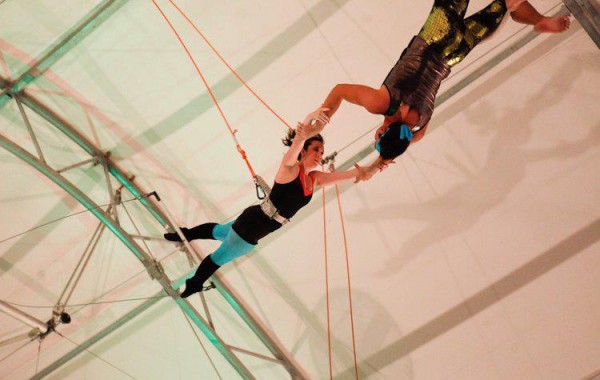Flying Through the Air with The Greatest of Ease
March 13, 2014

In 2012, Lauren Plumley, Fordham College at Lincoln Center (FCLC) ’16, ran off and joined the circus. It’s not quite as angsty as it seems—she wasn’t kidnapped by clowns or lured by an enigmatic but captivating ringmaster. Wanting a change of pace and a chance to get more formal training, Plumley took a year off school, left Hofstra University and joined Circomedia in Bristol, England. A year later, Plumley is back in New York, but the circus is very much still a part of who she is.
“It’s my life,” Plumley said.
Once a nationally-ranked gymnast, Plumley soon found herself retired after a back injury mid-adolescence. “I stopped when I was like 15, because it just hurt everywhere. So doing flying trapeze essentially was the same idea and it’s the same feeling and it didn’t hurt. For me, that was incredible,” Plumley said, explaining the origins of her interest in circus performance. “I was a competitive gymnast growing up so I went to a summer camp that has a really large circus program attached to it, so the skills transfer over really well,” Plumley said.
Realizing that gymnastics was no longer a viable option and that her love of physical performance ran strong, she became more serious about circus performing, specifically trapeze. “It was the first thing that I experienced that was similar enough to gymnastics but it didn’t come with the pain that gymnastics had,” she said. Trapeze, which is mostly aerial, relieves the impact that gymnastics has on the joints, while keeping athletic and artistic expression intact.
Falling more and more in love with circus performing as the year went on, Plumley began to feel the pull of the trapeze calling her back during her freshman year at Hofstra University. “I decided I wanted to do a short-term professional training program, and they had one that I was really interested in in Bristol,” Plumley explained. Plumley packed her bags for Bristol and enrolled at Circomedia, “an internationally respected centre of excellence for Contemporary Circus and Physical Theatre,” according to its website.
A fully integrated circus education is what Plumley got. “It was difficult, like full days of classes, so everything from like juggling and unicycling to acrobalance, partner balance, various aerials including flying trapeze and double trapeze, all of it. And physical theatre, which is acting with your body, kind of,” she added.
Plumley learned a lot about herself in her year in England, even finding romance among the ropes. Her first catcher, the anchor for the trapeze act who literally scoops up the flyer—the other artist who is airborne—out of the air, Jono Ayres, is now her boyfriend.
Another lesson Plumley learned was her preference for contemporary circus rather than traditional. “Traditional is what you think of with like Barnum and Bailey, Ringling Brothers, all that three-ring nonsense, with the ring master and the elephants and the horses and the clowns and all of that nonsense. Contemporary circus really tries to incorporate theater and movement in with the circus discipline, so it’s much less about like flash and more about telling a story,” Plumley said. A significant amount of popular circuses today lean more towards contemporary style, including Cirque du Soleil, Les 7 Doigts de la Main, and even aspects of La Soirée and Pippin, two shows currently playing in New York have a modern circus feel.
The main difference between traditional and contemporary is the emphasis modern circus performers put on telling a story through their act rather than relying on flash. “There was another piece that I was a part of that a friend of mine put me in, and basically, it was a story based on a play about a girl and her friends and their life and this girl basically dives into a pool and there’s no water in the pool and she dies,” Plumley said, explaining how trapeze can tell a narrative. “We told the story just using movement and the aerials and stuff to tell the story about the girl and her friends.”
After her sojourn across the pond, Plumley decided to come back to New York, choosing Fordham primarily for its location. “I chose Fordham because it is sort of the epicenter of a lot of the circus in New York City, because there’s circus on the East Side, circus below us, there’s circus in Queens.” Plumley takes five classes at FCLC, does 17 training class hours a week at Circus Warehouse and also teaches classes at Trapeze School New York. “A typical day, usually I get up and do whatever classes I have at Fordham that day, and then I do anywhere from one to five classes per day at Circus Warehouse, so that’s my personal training,” Plumley said. “I have ballet, contortion and fly. I come back, do homework if I decide to do my homework, bed, repeat. In between that, whatever shifts I work for Trapeze School New York.” Like most circus performers, Plumley is a master of balance, both in the air and on the ground. Plumley hopes to perform trapeze for now, but hopes to open up her own school someday, and is currently majoring in economics to achieve that goal.
Plumley credits running away to the circus as teaching her discipline, responsibility and self-reliance. “When you’re 30 feet in the air and you’re about to do a drop, you better know what you’re doing and you better be comfortable doing it because you can’t doubt yourself in that moment,” Plumley said. She takes lessons she learns from the circus and applies them to real life, like trusting the people she works with, committing fully and having confidence in herself.
“It helped me grow up” Plumley said.









